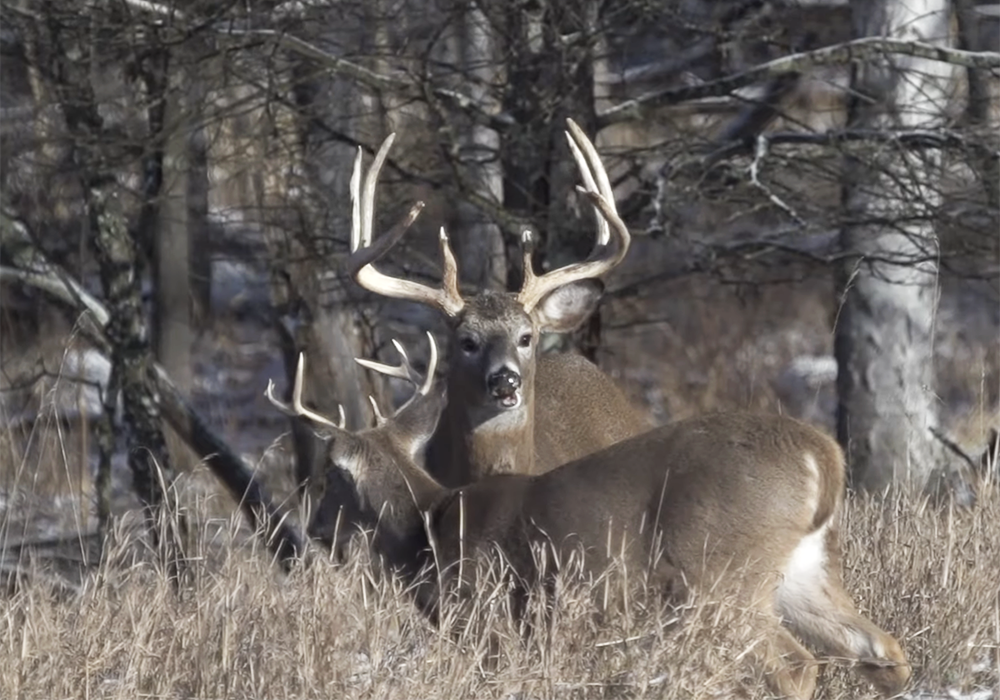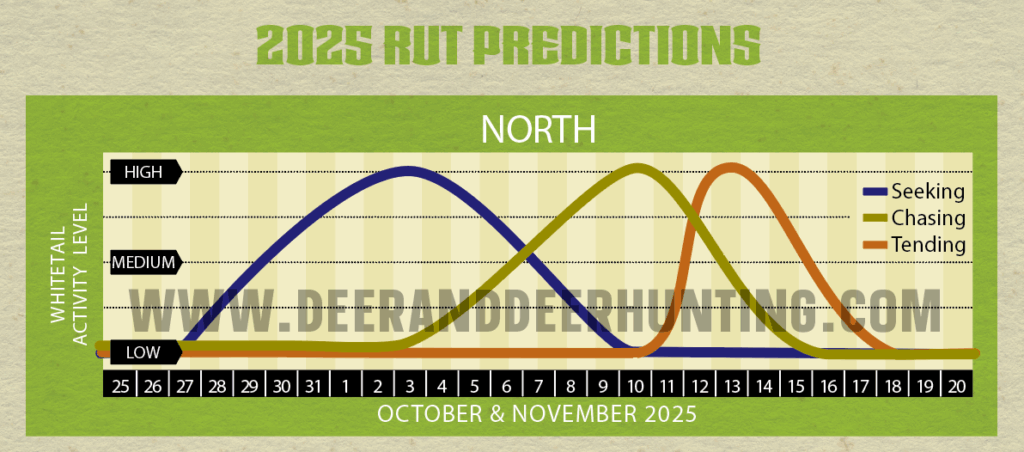It was the second week of November, and I was bowhunting in northeastern Iowa, a state known for its large deer population. The morning was ideal: clear, cold, and nearly calm. I could sense it was going to be a great day.
Sitting in my tree stand before dawn, waiting for shooting light, I heard deer running in the timber below the ridge where I was perched. The stillness amplified their sounds, making them seem closer than they were, likely moving along the small creek far below.
As the light remained dim, I heard a deer approaching. A doe burst from the woods, darted into a Conservation Reserve Program field, and ran straight toward my tree, positioned where the tall switchgrass met the dark timber. A large Iowa buck followed 20 yards behind. The doe sped past, and I drew my bow, grunting to stop the buck. He ignored my call. I let out a loud “blaaat!” but he kept moving. Panicked, I swung with him until my arm hit a branch, then released. My arrow landed in the frost-covered grass several feet behind him.

I regretted the shot until another doe appeared, running over a gentle hill in the field, chased by two young bucks. They darted into a brushy draw 200 yards south of my stand and vanished. Silence followed.
An hour later, I heard more deer behind me. Another doe, pursued by a buck, ran below my stand through the heavy timber and emerged from the same brushy draw. Through binoculars, I studied the buck as he chased the doe across the field. He had long tines but lacked the mass of a mature animal.
I considered moving my stand to the brushy draw, which seemed to be a key route between the field and timber. After seeing no more deer for an hour, I relocated. But the next deer — a nice buck — walked right under the oak tree I had just left.
By dusk, I saw three more bucks, though two were likely the same smaller ones from earlier. One chased a doe in circles around that oak where I had spent most of the morning.
That’s the chase phase: plenty of action, but choosing the perfect stand location can be maddening.
When Is It?
The chase phase is a brief period between the scraping phase and the breeding period. In the northern half of the whitetail’s range, these periods are distinct because the breeding period is predictable, short, and intense. This ensures fawns are born late enough to avoid spring blizzards but early enough to survive their first winter.
In southern states, where precise timing of births is less critical, the breeding period extends over weeks or months, making it harder to pinpoint the chase phase.
Short but Intense
In areas with a defined rut, the chase phase occurs at the end of the scraping period, just before the first does enter estrus. Bucks are frenzied, primed for action. A doe emits scent signals a day or two before estrus, triggering bucks to pursue her. Since she’s not ready to breed, she keeps moving, creating a frenzy when multiple does are in this state. No other period matches the chase phase for seeing numerous deer.
Timing Is Critical
The chase phase is short, so timing is key. Fortunately, it’s predictable. The peak breeding period occurs around the same dates each year, varying only slightly due to moon phase, weather, herd condition, or hunting pressure. If the breeding peak is Nov. 10-20, expect the chase phase from Nov. 6-12. It typically lasts only a couple of days, so hunt all day when possible.

This year the rutting moon (second full moon after the autumn equinox) is Nov. 5. Unlike last year, when the rutting moon fell on Nov. 15 and saw prime rutting activity at peak during early November. This year, the rutting action will pick up by Oct. 27 and be at fever pitch in early November in the North. So, let’s look at how this year’s rut will unfold in locations north of the 35th latitude.
North of the 35th Latitude:
Seeking phase: Around four or five days before the full moon arrives on Nov. 5, the rut’s seeking phase will ramp up and be evident by an increase in scraping, rubbing, daytime buck activity, and an increase in deer/car collisions in more populated areas.
Chase phase: By Nov. 5, it will be obvious this phase is full-blown. Chasing should be intense by the 10th of November if your area has a reasonable adult-doe-to-antlered-buck ratio, and a good number of bucks older than 2½ in the herd. When competition exists for breeding rights it nearly always equates to greater rutting behavior in the form of rubbing, scraping, chasing and fighting.
Breeding phase: Breeding will be noticeable from Nov. 10 to the 18th, with peak breeding occurring around Nov. 13. It’s during this phase that many hunters feel the rut is over due to a lack of deer sightings. Not so. The lack of sightings during the breeding phase has to do with the fact that an estrous doe might not move 100 yards from 24 hours before entering estrus to 12 to 24 hours after cycling out of estrus. This means that she can be very stationary for up to 72 hours, with a buck or multiple bucks attempting to breed her. So, unless you have a hot doe near your stand during this phase, deer sightings can be nonexistent.
The Rut’s Sweet Spot
If you are able to hunt only one week this year, you’ll be pleased to know that the rut does have a magic week to 10 days when deer activity is greatest.
All things being equal, the rut’s sweet spot this year will be from the full moon on Nov. 5 to the 15th. This period should be special because the rut will be exploding, providing great hunting opportunities.
Hunting Strategies
During the seeking and chasing phases, hunting strategies should focus on areas that have the greatest deer activity. During these phases, bucks can travel great distances and it’s not uncommon for a sexually active buck to cover up to 4,000 acres. So, setting up in prime travel corridors and pinch points should offer the best chance of ambushing rut-crazed bucks. These locations should also have the most rubbing and scraping sign. Strategies such as rattling and calling with a grunt tube should prove to be very productive during this time, especially if mature bucks are present.
Of the rut’s three phases the chase phase will have the greatest amount of deer activity taking place. Because of this it is wise to stay on stand all day if possible because bucks are often active throughout daylight hours during this phase.
When the breeding phase explodes, the best strategy is to hunt known doe groups, especially their prime food sources, because that’s where the bucks will be. In addition, hunters adept at using a call will have a great advantage during this phase. Being able to mimic the sound of does, fawns and bucks is just the ticket for bringing a lovesick buck into range.
Strategies
The chase phase is a favorite for many hunters because deer sightings are almost guaranteed in good whitetail country. However, positioning for a shot within bow range is challenging. Bucks chasing does are highly unpredictable. Here are some effective strategies:
Doe Decoys: A doe decoy can be highly effective during this phase, as bucks rush toward every doe they see. Place decoys in visible areas like field edges, clear-cuts, logging roads, or open woodlands. The more directions and distance from which a buck can spot the decoy, the better.
Funnels and Food Sources: Funnels are excellent due to heavy deer traffic. Food sources are even better, as bucks frequent areas where does feed, hoping to find one in estrus. These spots are ideal for decoys.
Calling and Rattling: This is the best time to use grunts or rattling to attract bucks. They’re highly responsive, mistaking your calls for another buck or a fight.
All Day Long
Hunt all day during the chase phase. While mornings and evenings are most active, bucks cruise for does throughout the day. If you take a break, do so between 1:30 p.m. and an hour before sunset, when deer movement is typically slowest.
— Longtime D&DH contributor Gary Clancy was one of North America’s best whitetail rut hunters. His articles and books on the topic educated generations of avid big-buck hunters.
Enjoying this article? Subscribe to our newsletter and get FREE deer hunting tips, guides to the latest gear, recipes, and much more.
